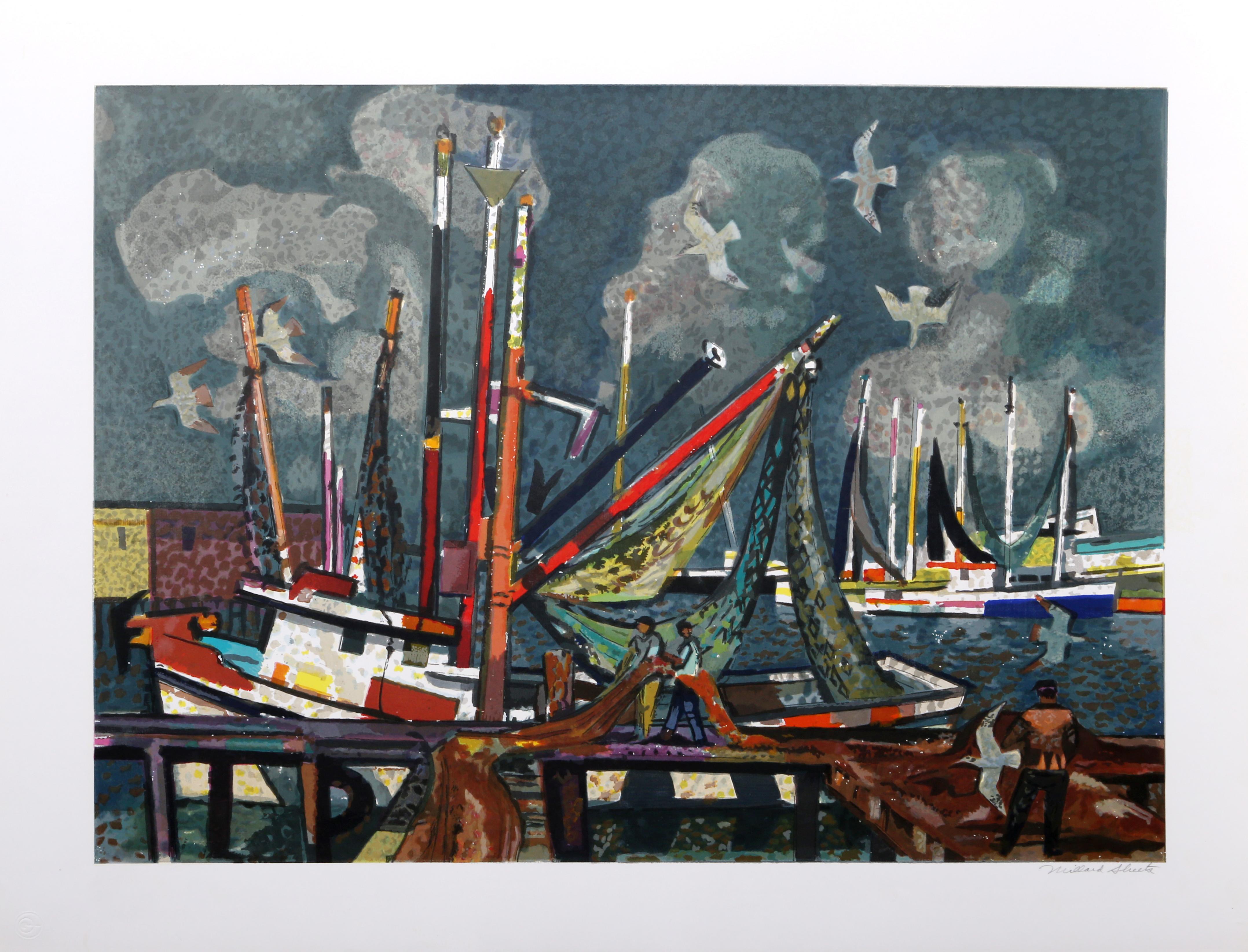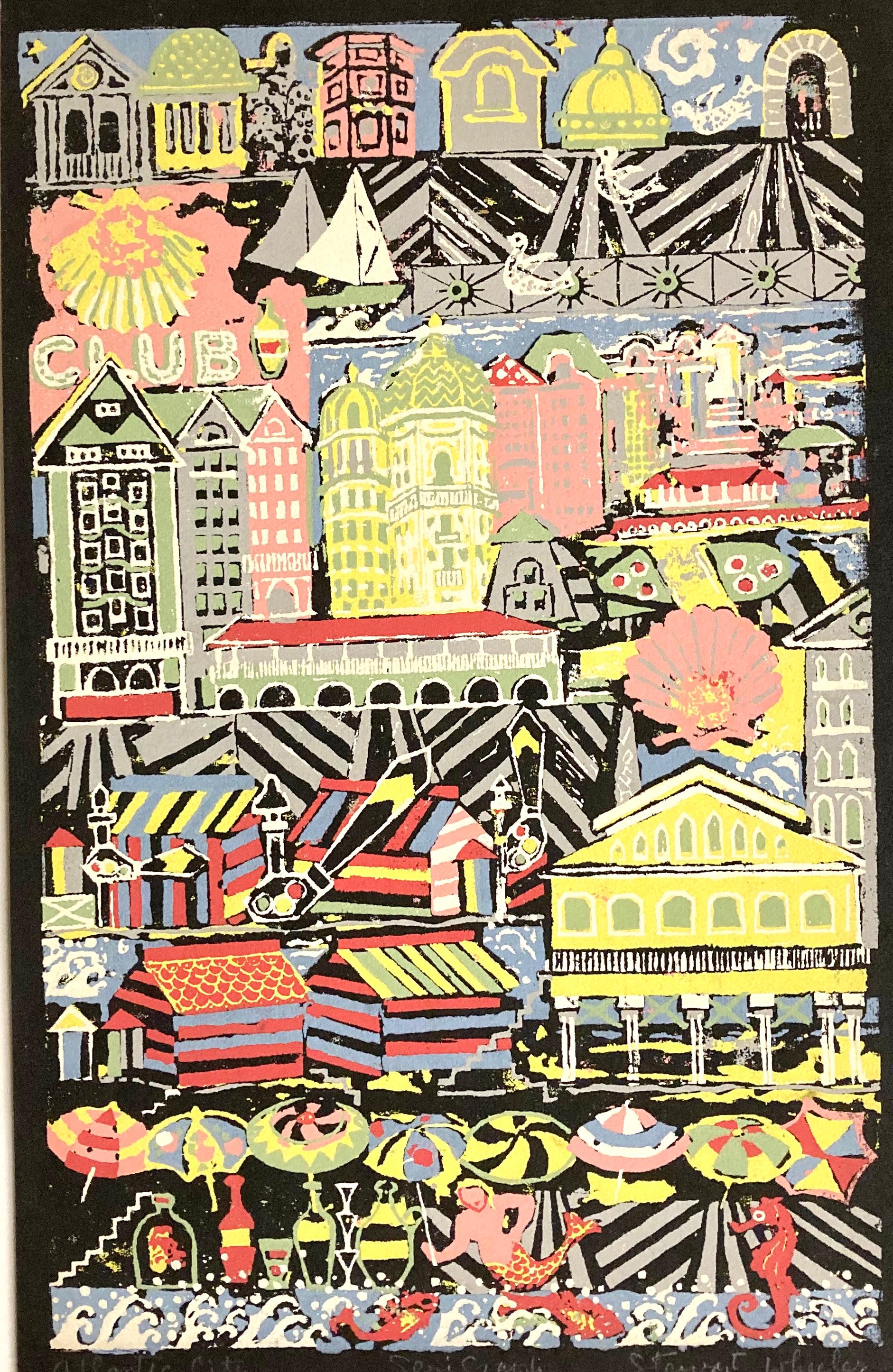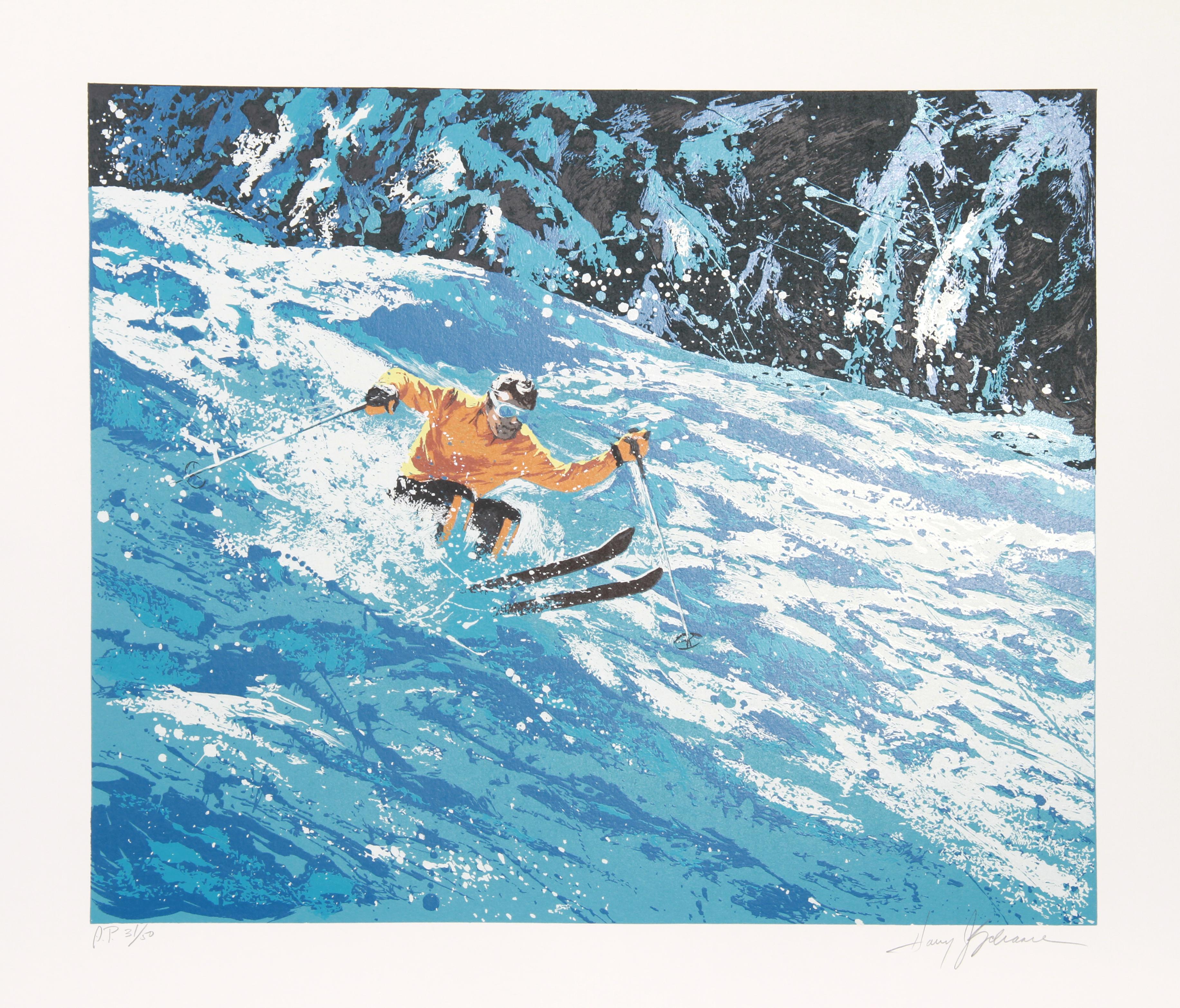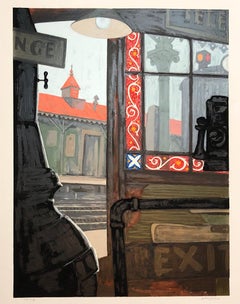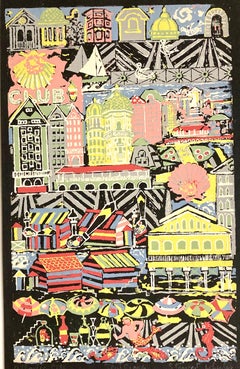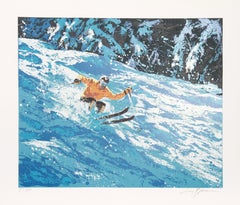Items Similar to New York Skyline at Night - Offset Poster, 2008
Want more images or videos?
Request additional images or videos from the seller
1 of 9
Andreas FeiningerNew York Skyline at Night - Offset Poster, 20082008
2008
About the Item
Andreas FEININGER
New York Skyline at Night, 2008
Offset original vintage poster
On paper 68 x 74 cm (c. 27 x 29 in)
Original poster for artist's exhibition in Fundation Juan March in 2008
Excellent condition
- Creator:Andreas Feininger (1906-1999, American)
- Creation Year:2008
- Dimensions:Height: 26.78 in (68 cm)Width: 29.14 in (74 cm)
- Medium:
- Movement & Style:
- Period:
- Condition:
- Gallery Location:Paris, FR
- Reference Number:1stDibs: LU46438773762
About the Seller
4.9
Platinum Seller
Premium sellers with a 4.7+ rating and 24-hour response times
Established in 2010
1stDibs seller since 2016
3,597 sales on 1stDibs
Typical response time: <1 hour
- ShippingRetrieving quote...Shipping from: Paris, France
- Return Policy
Authenticity Guarantee
In the unlikely event there’s an issue with an item’s authenticity, contact us within 1 year for a full refund. DetailsMoney-Back Guarantee
If your item is not as described, is damaged in transit, or does not arrive, contact us within 7 days for a full refund. Details24-Hour Cancellation
You have a 24-hour grace period in which to reconsider your purchase, with no questions asked.Vetted Professional Sellers
Our world-class sellers must adhere to strict standards for service and quality, maintaining the integrity of our listings.Price-Match Guarantee
If you find that a seller listed the same item for a lower price elsewhere, we’ll match it.Trusted Global Delivery
Our best-in-class carrier network provides specialized shipping options worldwide, including custom delivery.More From This Seller
View AllWashington Sun - Original Screenprint, Handsigned
By Jacques Monory
Located in Paris, IDF
Jacques Monory
Washington Sun , 1976
Original screen print
Handsigned
On BFK Rives 38 x 28 cm (c. 14x 11 in)
Limited to 300 exemplary, not numbered
INFORMATION: This work is publi...
Category
1970s American Modern Portrait Prints
Materials
Screen
New-York : Statue of Liberty - Original Screenprint, Handsigned
By Jacques Monory
Located in Paris, IDF
Jacques Monory
Statue of Liberty, 1976
Original screen print
Handsigned in pencil
On BFK Rives 38 x 28 cm (c. 14x 11 in)
Limited to 300 proofs, not numbered
INFORMATION: This work...
Category
1970s American Modern Landscape Prints
Materials
Screen
Jacques Monory - (Baseball) Pride, fear and confusion - Original Screenprint
By Jacques Monory
Located in Paris, IDF
Jacques Monory
Pride, fear and confusion, 1976
Original screen print
Handsigned
On BFK Rives 38 x 28 cm (c. 14x 11 in)
Limited to 300 exemplary, not numbered
INFORMATION: This wor...
Category
1970s American Modern Portrait Prints
Materials
Screen
Jacques Monory - The American Dream , 1976, Original Screenprint
By Jacques Monory
Located in Paris, IDF
Jacques Monory
The American Dream, 1976
Original screen print
Handsigned
On BFK Rives 38 x 28 cm (c. 14x 11 in)
Limited to 300 proofs, not numbered
INFORMATION: This work is publi...
Category
1970s American Modern Portrait Prints
Materials
Screen
$232 Sale Price
33% Off
New York: Empire State Building - Quadrichromie Poster, 2008
By Andreas Feininger
Located in Paris, IDF
Andreas FEININGER
New York : Empire State Building, 2008
Quadrichromie original vintage poster
On paper 92 x 68 cm (c. 36 x 27 in)
Original poster for artist's exhibition in Fundati...
Category
Early 2000s American Modern Landscape Prints
Materials
Screen
New York City, The El at Chatham Square - Original lithograph , Handsigned / 100
By Adriaan Lubbers
Located in Paris, IDF
Adriaan Lubbers
New York City, The El at Chatham Square, 1930
Original lithograph
Handsigned in pencil
Numbered / 100
On Rives vellum 28 x 22.5 cm (c. 11 x 9 in)
Very good condition
Category
1930s American Modern Landscape Prints
Materials
Lithograph
You May Also Like
Modernist Silkscreen Screenprint 'El Station, Interior' NYC Subway, WPA Artist
By Anthony Velonis
Located in Surfside, FL
screenprint printed in color ink on wove paper. New York City subway station interior.
Anthony Velonis (1911 – 1997) was an American painter and designer born in New York City who helped introduce the public to silkscreen printing in the early 20th century.
While employed under the federal Works Progress Administration, WPA during the Great Depression, Velonis brought the use of silkscreen printing as a fine art form, referred to as the "serigraph," into the mainstream. By his own request, he was not publicly credited for coining the term.
He experimented and mastered techniques to print on a wide variety of materials, such as glass, plastics, and metal, thereby expanding the field. In the mid to late 20th century, the silkscreen technique became popular among other artists such as Robert Rauschenberg and Andy Warhol.
Velonis was born into a relatively poor background of a Greek immigrant family and grew up in the tenements of New York City. Early on, he took creative inspiration from figures in his life such as his grandfather, an immigrant from the mountains in Greece, who was "an ecclesiastical painter, on Byzantine style." Velonis attended James Monroe High School in The Bronx, where he took on minor artistic roles such as the illustration of his high school yearbook. He eventually received a scholarship to the NYU College of Fine Arts, into which he was both surprised and ecstatic to have been admitted. Around this time he took to painting, watercolor, and sculpture, as well as various other art forms, hoping to find a niche that fit. He attended NYU until 1929, when the Great Depression started in the United States after the stock market crash.
Around the year 1932, Velonis became interested in silk screen, together with fellow artist Fritz Brosius, and decided to investigate the practice. Working in his brother's sign shop, Velonis was able to master the silkscreen process. He reminisced in an interview three decades later that doing so was "plenty of fun," and that a lot of technology can be discovered through hard work, more so if it is worked on "little by little."
Velonis was hired by Mayor LaGuardia in 1934 to promote the work of New York's city government via posters publicizing city projects. One such project required him to go on a commercial fishing trip to locations including New Bedford and Nantucket for a fortnight, where he primarily took photographs and notes, and made sketches. Afterward, for a period of roughly six months, he was occupied with creating paintings from these records. During this trip, Velonis developed true respect and affinity for the fishermen with whom he traveled, "the relatively uneducated person," in his words.
Following this, Velonis began work with the Public Works of Art Project (PWAP), an offshoot of the Civil Works Administration (CWA), where he was assigned to serve the different city departments of New York. After the formation of the federal Works Progress Administration, which hired artists and sponsored projects in the arts, he also worked in theater.
Velonis began working for the federal WPA in 1935. He kept this position until 1936 or 1938, at which point he began working in the graphic art division of the Federal Art Project, which he ultimately led. Under various elements of the WPA program, many young artists, writers and actors gained employment that helped them survive during the Depression, as well as contributing works that created an artistic legacy for the country.
When interviewed in December 1994 by the Library of Congress about his time in the WPA, Velonis reflected that he had greatly enjoyed that period, saying that he liked the "excitement" and "meeting all the other artists with different points of view." He also said in a later interview that "the contact and the dialogue with all those artists and the work that took place was just invaluable." Among the young artists he hired was Edmond Casarella, who later developed an innovative technique using layered cardboard for woodcuts.
Velonis introduced silkscreen printing to the Poster Division of the WPA. As he recalled in a 1965 interview: "I suggested that the Poster division would be a lot more productive and useful if they had an auxiliary screen printing project that worked along with them. And apparently this was very favorably received..."
As a member of the Federal Art Project, a subdivision of the WPA, Velonis later approached the Public Use of Arts Committee (PUAC) for help in "propagandizing for art in the parks, in the subways, et cetera." Since the Federal Art Project could not be "self-promoting," an outside organization was required to advertise their art more extensively. During his employment with the Federal Art Project, Velonis created nine silkscreen posters for the federal government.
Around 1937-1939 Velonis wrote a pamphlet titled "Technical Problems of the Artist: Technique of the Silkscreen Process," which was distributed to art centers run by the WPA around the country. It was considered very influential in encouraging artists to try this relatively inexpensive technique and stimulated printmaking across the country.
In 1939, Velonis founded the Creative Printmakers Group, along with three others, including Hyman Warsager. They printed both their own works and those of other artists in their facility. This was considered the most important silkscreen shop of the period.
The next year, Velonis founded the National Serigraph Society. It started out with relatively small commercial projects, such as "rather fancy" Christmas cards that were sold to many of the upscale Fifth Avenue shops...
Category
1980s American Modern Figurative Prints
Materials
Screen
Fisherman, Modern Silkscreen by Millard Sheets
By Millard Sheets
Located in Long Island City, NY
Fisherman by Millard Owen Sheets, American (1907–1989)
Date: circa 1977
Lithograph, signed in pencil
Edition of AP
Image Size: 22 x 29.5 inches
Siz...
Category
1970s American Modern Landscape Prints
Materials
Screen
Stewart Wheeler, Atlantic City (New Jersey)
Located in New York, NY
The little that is know about the painter and printmaker Stewart Wheeler indicates that most of his career was spent in Philadelphia, Pennsylvania. And...
Category
Mid-20th Century American Modern Landscape Prints
Materials
Screen
Skiing II, Pop Art Screenprint by Harry Schaare
By Harry Schaare
Located in Long Island City, NY
Skiing II
Harry Schaare, American (1922–2008)
Date: 1979
Screenprint, signed and numbered in pencil
Edition of 300, AP 50
Image Size: 20 x 24 inches
Size: 26 in. x 30 in. (66.04 cm x...
Category
1970s American Modern Landscape Prints
Materials
Screen
May Day, Folk Art Screenprint by Ralph Fasanella
By Ralph Fasanella
Located in Long Island City, NY
Artist: Ralph Fasanella, American (1914 - 1997)
Title: May Day
Year: 1974
Medium: Serigraph, signed and numbered in pencil
Edition: 250
Size: 31 in. x 43 in. (78.74 cm x 109.22 cm)
Category
1970s American Modern Landscape Prints
Materials
Screen
Taos Pueblo
By Anna Barry
Located in Fairlawn, OH
Taos Pueblo
Screen print in colors, c. 1945
Signed and titled in pencil by the artist
Printed in Taos
Taos is the oldest continually inhabited city/village in North America.
How old ...
Category
1940s American Modern Landscape Prints
Materials
Screen

